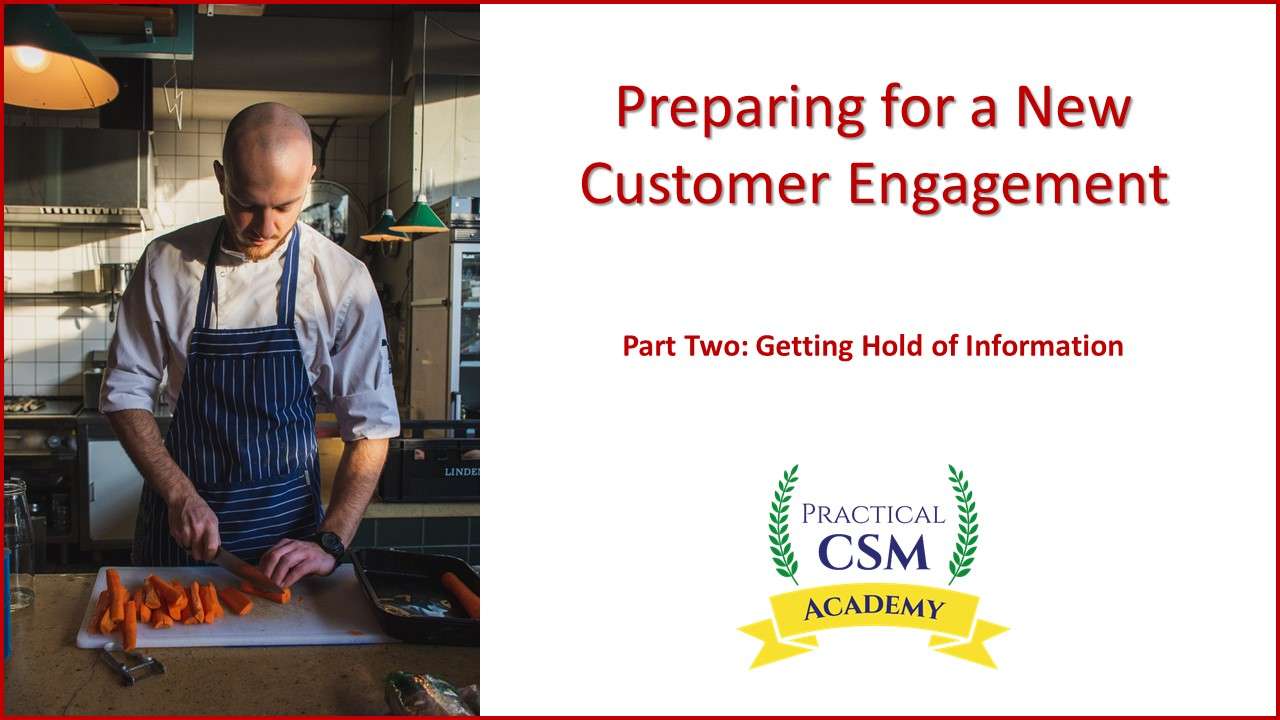Preparing for a New Customer Engagement Part Two: Getting Hold of Information
Accessing the Information You Need
Where to Find Information
At this early stage in preparing for the customer engagement you may well not yet have had the opportunity meet the customer’s lead stakeholder (I refer to this person as the SPL – Senior Project Lead) or other customer stakeholders and to introduce yourself and explain the role of customer success management in helping achieve their outcomes from their initiative. This will not always be the case – sometimes for example you may already know the stakeholders intimately because of your involvement in other engagements with the same customer. Other times you may have been invited by the account manager to come in to meet and introduce yourself to customer stakeholders during a pre-sales meeting. Incidentally if this latter situation is the case then what you have there is a forward thinking account manager whom it would definitely pay to remain in touch with. Commonly however, you will be working towards your first customer meeting, and indeed part of the purpose of the research you are doing is to ensure you are well prepared for that initial meeting when it does occur.
For now we will assume that you will not be meeting the customer stakeholders until after this initial research has taken place. So if we leave out the route of asking customer stakeholders for the information we want, where should we look for it? The answer is in three principle locations: your company’s pre-adoption team and most importantly the account manager, your company’s data systems, and most importantly the CRM (customer relationship management) system, and the Internet. Let’s examine each of these locations in more detail.
Talking to the Pre-Adoption Team
The first port of call for most CSMs who are looking for information about the customer, the initiative, the solution that was purchased, and the progress that has been made to date should be their colleagues who have already been involved in the engagement. This includes but is not necessarily limited to those people who were involved in the sales process. In addition to the sales process it might also involve people who were involved in design, custom development or other customization, installation, integration, configuration, and the provision of professional and managed services.
The AM (account manager) is the obvious start point in talking to the pre-adoption team. This is because the AM for a particular customer is generally easy to identify and because the account management role requires this person to have a good overall understanding of all aspects of the engagement. The AM can usually therefore both provide the CSM with a thorough briefing about most aspects of the customer engagement and serve as an excellent source of information as to who else the CSM should go to in order to collect any additional information that may be required.
Whenever you meet other people it is important to recognize they are indeed people, not automatons. This means they come with emotions and feelings, and with pre-conceived opinions and judgements. They may for example be suffering under the stress of a particularly heavy workload right now, or struggling to meet important role-based targets that direct impact their remuneration. Additionally they may not understand the role of the CSM or recognize the value that customer success management can deliver to the customer and potentially to themselves. In fact for some of your colleagues they may even see the CSM as a threat to their own success.
Many AMs, sales specialists, design architects, service managers, consultants and other members of the pre-adoption team are likely to be well educated in the value the customer success management brings and are very happy to work closely with CSMs in their customer engagements. However you need to be aware of potential issues within your own organization where colleagues may not understand the purpose and value of customer success management and may even perceive it as a threat to their own personal success. Where problems do exist, you won’t necessarily be able to fix these problems – and certainly not overnight – but by making yourself aware of them you can plan to deal with them as best you can by engaging the necessary resources for problem resolution.
Sometimes it may be lack of education about customer success management that is causing the problem. Other times it may simply be a lack of time available or an unwillingness to share information. Whatever the case, the CSM needs to think about how they can present their role and the benefits it brings to both customer and your own company to those colleagues who are not yet familiar with this information, so that they understand both that it is of value to them and to the customer and that it does not threaten their own position. Most importantly you need to make sure you show the value of working with the CSM to that person in the role they occupy. Where a difficult relationship exists, try to make it easy for them to do what you want them to do. If that means you travelling out to meet them where they happen to be, or you fitting in an awkward meeting time when they happen to be free then so be it. Remember that at this stage in the proceedings it is you who wants something from them, not the other way around. Of course as your customer success organization matures and becomes a valued fixture within your company’s overall structure, your colleagues from other parts of the business will start to see customer success in its true light, and treat it accordingly. So if this issue does arise for you, consider it as a temporary problem – one that will only occur during the initial “bedding in” process that is perhaps an inevitable concomitant of the newness of the customer success role.
A final thought on this important topic. Managing people is a critical skill for all CSMs to have. We often think of people management (or stakeholder management) as being all about managing the relationships we have with the customer, but the management of relationships with others within our own company is equally if not even more important, since we will potentially need to work with those people on many different customer engagements on into the future.
Interrogating Corporate Data Systems
Much of the information you need may be stored in your company’s data systems. This is likely to include systems that store records about customers such as your customer relationship management (CRM) system. It is also likely to include information systems that store data on and that manage your company’s products and services. This might include for example customer support systems and in the case of Software-as-a-Service (SaaS) organizations it might also include systems that host the products and services themselves and that make them available for customers to log in and use.
Researching on the Internet
Another obvious port of call for information is the Internet. The Internet holds a fantastic amount of information, not all of which is accurate or up-to-date. It is an excellent source of information for CSMs – especially about customers who are in the public eye such as brand name organizations, government funded entities and business whose shares are publically traded. For these types of organizations there will generally be substantial amounts of data for the CSM to review. A good starting point is generally of course the customer’s own corporate website, but there may well be other sites that contain equally interesting information. These may include websites relating to the customer’s industry, websites relating to the financial industry, websites from the news media sector and websites from relevant government agencies.
It is generally a good idea to try to get information from more than one source, as information gathered from multiple locations tends to provide a more rounded and insightful view of the customer than information gathered from just one location. Remember that even if a particular information is trustable, they may still have a bias or an “angle” that paints a less three-dimensional picture of your customer’s business than exists in reality. In addition to checking the quality of the source of any information you uncover via the Internet do also make sure you know how up-to-date it is. Sometimes information can remain relevant for a long time, but other information becomes rapidly out of date. Be aware of this as you conduct any Internet research.
Validation of Information
One final point about researching in preparation for the onboarding process is about the process of validation. Validation is the act of checking information to ensure its accuracy and completeness. Having information is one thing, but knowing that the information you have is accurate and complete is another. Whenever you research information relating to your customer success management role, you need to be aware of the level of trustworthiness you can place on the sources of information you are going to. This applies to all information from all sources whether internal to your own company, from the customer stakeholders or (of course) from the Internet more widely.







